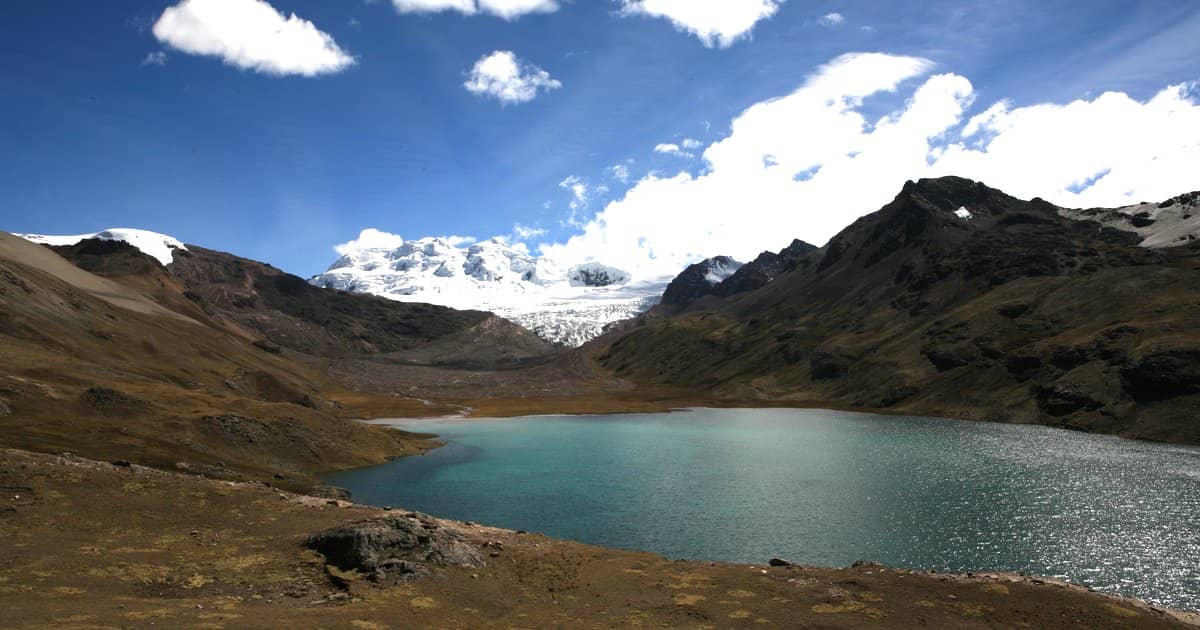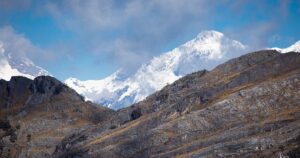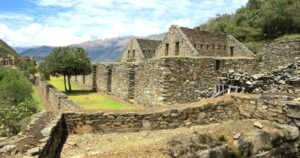On this world-class Ausangate trek, you spend five days and four nights in close proximity to Nevado Ausangate (elevation: 6,384 m/20,945 ft), the highest sacred mountain in the Andes of southern Peru. You travel in harmony with nature, welcomed by the isolated Andean shepherds who live in these high valleys. At night you enjoy the solid comfort of cozy and eco-friendly Andean Lodges, built and furnished to provide comfort and style to satisfy travelers from all over the world.
2023-2024 Departures: 5 Days/4 Nights, each Friday from Cuzco
Rates per person, based on double occupancy
| Group Size | Rate per person in double room | |
|---|---|---|
| 2023 | 2024 | |
| 4-16 people | $1,450 | $1,600 |
| 3 people | $1,850 | $1,860 |
| 2 people | $2,850 | $2,860 |
| 1 person | $5,750 | $5,760 |
Single Supplement: $350
While the 5-day/4-night trek is the classic route, we also offer a 6-day/5-night version which gives you an extra night at the first lodge. This longer version gives you an extra day to acclimate at 14,000 feet, as well as the option to hike to a mountain lake.
Departures: The trekking season runs from March through November. Private departures can leave any day Saturday to Wednesday, but please inquire for availability.
Regular group departures are as follows, March – November:
Every Thursday: 6D/5N
Every Friday: 5D/4N
Please contact Machu Picchu Climb for details.
This peerless Peru trip offers you five days and four nights trekking with spectacular close-range views of Nevado Ausangate (6,384 m / 20,945 ft), the highest sacred mountain in the Andes of southern Peru. This Ausangate trek brings you to one of the most pristine mountain ecosystems on our planet, the home of the “llamichus” and “pacocheros” (llama and alpaca breeders), inheritors of one of the most traditional pastoral societies in the Andes.
You’ll enjoy an unforgettable Peru trip as you visit two indigenous Andean communities through whose land we travel. Discover the beauty of the Cordillera Vilcanota, a remote and unspoiled high mountain paradise. You travel in harmony with nature, welcomed by the isolated Andean shepherds who live in these high valleys. At night you enjoy the comfort of cozy, eco-friendly Andean Lodges, built and furnished to provide comfort and style to satisfy travelers from all over the world.
DAY ONE – TO CHILLCA: We depart from Cuzco with an interesting bus-ride along the valley of the Vilcanota River. After a visit to the beautiful colonial church at Checacupe, we ascend the Pitumarka River valley, past the community of Osefina, to Chillca. We have lunch at 14,077 ft by the ruins of an old mill built by a rushing mountain stream, then begin our trek following the stream up through a ravine and out onto the beautiful pastures of Chillca community. From here it’s a 30 minute walk to the Chillca Tambo (4,368 m / 14,327 ft). After settling in, you have time to explore the surroundings, or just to relax and enjoying the beautiful views. In the evening people from the village entertain our groups with traditional music.
DAY 02 – CHILLCA – MACHURACAY: Our hike begins in the wide valley of Upis where impressive glaciated mountains loom above the valley offering majestic views. The trail narrows as we make our way towards the waterfalls descending from the Santa Catalina mountain. This path is mostly used by the wandering llamas of the area. Once we reach the small Paloma lagoon the countryside is dotted with these animals, and also a large number of alpacas. After hiking along a second lagoon and crossing a long series of moraines, we will reach the Machuracay Tambo (4,805 m/15,760 ft) located at the base of Apu Ausangate.
DAY 03 – MACHURCAY – ANANTAPATA: After a demanding ascent of the Palomani pass at an elevation of 5,150 m. / 16,892 ft., we descend to Ausangatecocha. Tremendous views of the glaciated south face of the “apu” will inspire us as we continue towards the red sandstone formations of the “Nevado del Inca”. Overnight stay in the Anantapata Tambo (4,700 m/15,416 ft).
DAY 04 – ANANTAPATA – HUAMPOCOCHA: A spectacular part of the trail finds us hiking in the middle of mountains with red, ochre, and blue strata. This section offers a glimpse of marvelous geological wonder and natural beauty. Also, be on the lookout for groups of gracious vicuñas, as they are frequently spotted in this isolated area. We will sleep that night in the Huampococha Tambo (4,818 m/15,803 ft) in the heart of large rock formations near a lagoon where “huallatas” (Andean geese) make their nests. 11.6 km.
DAY 05 – HUAMPOCOCHA – CUZCO: After a last climb over the Anta pass (4,908 m/16,098 ft), we gradually make our descent. In this section the first crops and houses come into view. The landscape changes quickly as the red sandstone formations are followed by the carsten erosion of limestone, forming a one of a kind stone forest, and a perfect habitat for “vizcacha” (members of the chinchilla family). By the time we get down the valley to Congomire (3,886 m/12,746 ft), our bus will be waiting for the return trip to Cusco.
Included: Expert leadership on the entire trek package, private transport to Chillca and back to Cusco, Lodging with double occupancy rooms, private bathrooms for each room (running cold and hot water), duffle bag (for the luggage carried by horses), walking sticks, all meals on the trek, including a hearty breakfast, picnic style lunch and a 3-course dinners served with wine. First Aid, Oxygen
Excluded: personal equipment and items of a personal nature, insurance, laundry
How difficult is this trek?
The Ausangate trek itself is rather demanding, mostly due to the altitude, ranging from 13,200 ft/4,300 m to 16,700 ft/5,100 m at the highest pass. There are also some significant changes of altitude during the course of each trekking day. The lodges are all easily reachable in six to seven hours at a regular hiking pace, with generous allowance made for taking pictures and enjoying the landscape.
Do I have to carry my own gear?
While on the trail, hikers carry only a daypack (camera equipment, water bottle, extra layers, rain gear, and other accessories they might need). Llamas carry a large part of the group luggage; we also bring a few horses. Weary participants can continue the trip on horseback.
What if I get sick?
In our lodges and on the trek we use radio communication and we always take along oxygen and essential first aid equipment.
When is the best time to take this trek and what kind of weather can I expect?
There are only two seasons in this latitude, a dry one (April-October) and a wet one (November-March) with plenty of rain (and snow at high altitude). We normally operate from April-October, when the weather is typically dry and stable. Occasional rain showers can occur at any time of the year. Temperatures vary very little during daytime, but drop drastically at night. While temperatures in the dry season (the Andean winter) often drop below freezing at night, you enjoy a comfortable overnight stay in our warm tambos.
What should I bring?
- Backpack/daypack
- Comfortable hiking boots and good socks
- Tennis shoes or sandals to wear around town
- Gore-Tex jacket and pants/Rain gear
- Long underwear
- Layered clothing for varied conditions from warm to cold
- Gloves
- Sunglasses, sunscreen, lip balm,
- Hat for sun protection and a ski hat for the cold
- Water bottle (or alternate personal hydration system)
- Extra batteries for your camera equipment (they might last less in low temperature and there is no possibility to recharge them), memory cards and/or film
- Binoculars
- (Small) flashlight/head lamp
- Pocket knife
- Toiletries/small first aid kit/all personal medications
- Energy bars
How should I prepare for this trek, and what is the best way to deal with the high altitude?
To enjoy this Ausangate trek, you need to be in good health. Participating in an active program of physical conditioning in the weeks leading up to your trek will help you make the most of your time in the mountains. We require that you spend at least 4 days at elevation prior to commencing the trek. It’s difficult to predict how altitude will affect individuals. Reactions appear to be independent of age and physical condition. Above 10,000 ft/3,000 m, the most common mild symptoms are: headache, loss of appetite, dizziness, and insomnia. Following simple rules upon arriving in Cuzco, 11,100 ft/3,400 m, help reduce initial disturbances (resting, slower walking, light meals, plenty of water and coca tea and less alcohol etc.). Many of our travelers find that the prescription medication Diamox helps with initial adjustment to the elevation.
What are the altitudes on this trek?
- Lima: 177 ft/54 m above sea level
- Cuzco: 11,100 ft/3392 m above sea level
- Highest lodge: Machuracay Tambo, 15,748 ft/4,800 m above sea level
- Highest point of the trip: Palomachayoc Pass, 16,700 ft/5,100 m above sea level
THE AUSANGATE PEOPLE
Today’s Alpaca herders inherited thousands of years of cultural acquisitions, reaching back to the indiscriminate hunters who first settled in the Andes some 14,000-16,000 years ago. The neolithic arrivals became specialized hunters, who developed a technique that forced the selected prey to run through previously built walls into corrals. At the same time they protected the herds from natural predators, principally pumas. The symbiotic relationship with the animals developed into domestication, herding, and selective breeding. In current times, during the ritual marriages of the Alpacas, they are called in Quechua “Huywa, our offspring — a gift of the gods. The day that there are no more alpacas in the puna, man will also disappear.” (Guaman Poma de Ayala)
The protector Mountain God, or Apu, is Ausangate. From him is born the water, male energy of the mountain, flowing over mother earth, making her fertile and able to support life. Later those waters flow into the unknown lands of the Amazon, from where they return every night, converted in the Milky Way to replenish the sacred ice of the mountain.
Quick Facts
- 5 days hiking/4 nights in mountain lodges
- In/Out Cuzco
- Remote & exhilarating – trek in the shadow of Nevado Ausangate (6,374m/20,900′)
- Rest each evening in beautiful eco-friendly Andean lodges
- View rare high-altitude wildlife, and an amazing geological landscape of reds and blues
- Add-on to visit Machu Picchu before or after the trek



